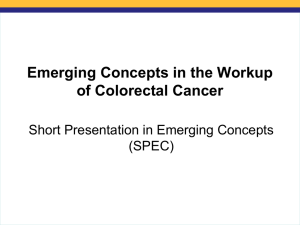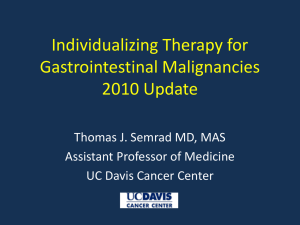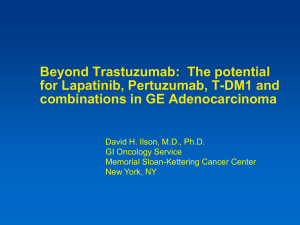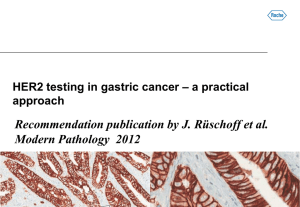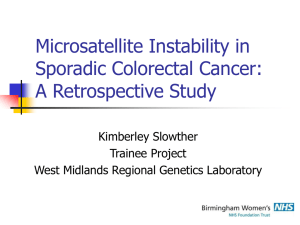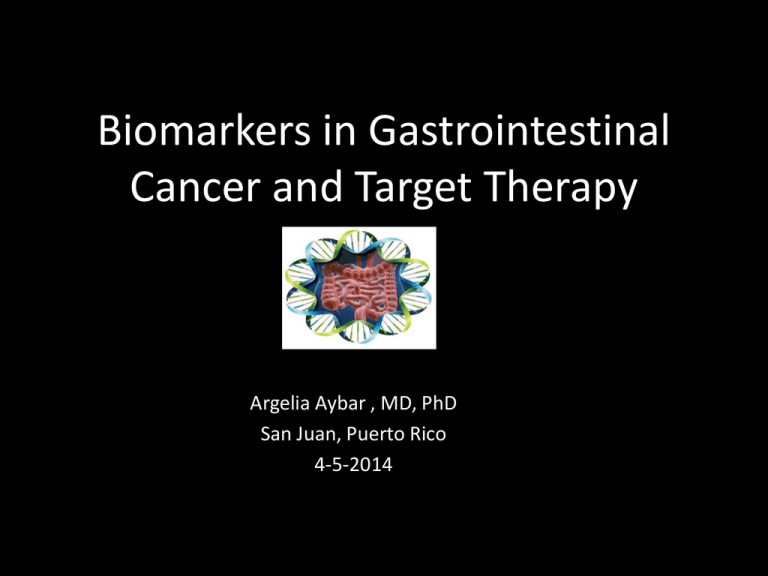
Biomarkers in Gastrointestinal
Cancer and Target Therapy
Argelia Aybar , MD, PhD
San Juan, Puerto Rico
4-5-2014
Objective
• Review the targeted therapies that are
currently standard of practice in colorectal
and gastric cancers, requiring specific
molecular testing for selection of candidate
patients for therapy.
Introduction
• Clinical applications of genomic medicine and
molecular diagnostics based on testing of
tumor tissues are becoming a reality in clinical
practice, with significant impact on
personalized therapies for cancer patients.
• Advances in targeted therapies for cancers of
the gastrointestinal tract have recently
emerged and are rapidly moving targets.
Gastric and Gastroesophageal Cancers
• Targeting HER2 Receptors
The human epidermal growth factor receptor 2 (Her2 or ErbB2) was first described in gastric cancer in 1986.
HER2 has no known ligand (orphan receptor), and
preferentially heterodimerizes with HER3, which lacks intrinsic
tyrosine kinase activity.
The HER2 and the HER2/HER3 heterodimers are likely to be
the most effective complex for activating downstream
pathways.
Targeting Her 2
• Overexpression and amplification of HER2
have been described in 6–35% of gastric and
gastroesophageal
junction
(GEJ)
adenocarcinomas.
• Criteria for interpretation of HER2 modified
for gastric and GEJ adenocarcinoma have been
recently reviewed.
Targeting Her 2
• Heterogeneity of HER2 expression occurs
frequently in gastric and GEJ adenocarcinoma;
however, testing is often done in biopsies
when no resection specimen is available.
• The College of American Pathologists (CAP)
reviewed current guidelines for interpretation
of HER2 expression
Targeting Her 2
• Criteria for interpreting HER2 IHC on gastric and GEJ
carcinomas differ significantly from the criteria used in
breast cancer.
• First, gastric carcinoma interpretation criteria use 10%
tumor cell staining as a cutoff to distinguish negative
from 1+.
• In gastric carcinoma, the distinction between 1+, 2+,
and 3+ depends on the intensity of staining presuming
that more than 10% of tumor cells show HER2
expression.
Targeting Her 2
Second, gastric cancers only show expression along the
basolateral or lateral cell membranes, while apical
membranes are negative. Therefore, the criteria for 2+ and
3+ staining in gastric cancer require only lateral or
basolateral staining, in contrast to breast cancer criteria
criteria which require complete, circumferential staining.
Third, the criteria for HER2 over expression differ when
interpreting biopsy and resection specimens due to
heterogeneity of HER2 expression in gastric and gastroesophageal junction carcinomas .
Morphological Features Her 2+
• Proximal gastric carcinomas with intestinal
phenotype are generally found to have a higher
prevalence of HER2-positivity (range 8-34%) than
distal diffuse gastric carcinomas .
• The rate of HER2-positivity in esophageal
adenocarcinoma is also variable, with one metaanalysis showing approximately 25% of
esophageal adenocarcinomas over-expressing
HER2.
HER2 Immunoscoring
Her 2 CISH
Conclusion
• HER2 expression has become an important
biomarker for identifying patients who could
respond to HER2 targeting therapy using the
fully humanized monoclonal antibody
trastuzumab.
• It is now recommended that all patients with
gastric cancer should have their tumors tested
for HER2 status at the time of initial diagnosis.
Introduction
• Colorectal cancer has been shown to arise
through at least two distinct genetic pathways:
• One
involves
chromosomal
instability
(demonstrating high frequency of structural
chromosomal changes) and
•
• The other involves microsatellite instability (MSI)
(demonstrating DNA microsatellites changes).
Colon Cancer Genetic Pathways
CK7+/p53−/MLH-1−/BRAFmutated/K-ras-wt/M SI
CK7+/CK20+/p53−/MLH1+/BRAF wt/K-rasmutated/MSS
Molecular classification of CRC as described by Jass
Microsatellite Instability (MSI)
• Microsatellites are normal segments of DNA
with repeat sequences of nucleotides of set
length.
• Change in the number of repeats or its length
(as a result of nucleotide insertions or
deletions) is called microsatellite instability
(MSI which is caused by defective DNA
mismatch repair genes (dMMR).
MSI
• Microsatellite instability in tumors has been
classified into three categories:
• 1- High (tumors showing instability in 30% or
more of the microsatellites).
• 2- Intermediate (instability in 10%–30%).
• 3- Stable tumors (less than 10%).
MSI
• Patients with MSI-H tumors, have a relatively
stable diploid karyotype.
• They typically have right sided or proximal
tumors.
• They usually exhibit improved overall survival.
MSI Morphological Features
•
•
•
•
Mucinous adenocarcinoma,
poor differentiation,
medullary carcinoma,
tumor infiltrating lymphocytes TILs (five or more in at least
one of 10 HPF),
• Crohn‟s-like reaction and
• serrated adenocarcinoma heterogeneity
• Some of the most recent researchers showed that more
than 15% of CRCs express CK7 and/or are CK20-negative.
This aberrant immunophenotype seems to be related to
microsatellite instability being more frequent in BRAFmutated MSI cases localized in the proximal colon.
MSI Morphological Features
The morphology of SAC. A
showing epithelial serrations,
abundant and eosinophilic
cytoplasm, and vesicular nuclei.
cell balls floating in the
extracellular mucinSAC
papillary rods in the extracellular
mucin. HE.
Immunoexpression of Cytokeratin 7 in case of possible
serrated pathway colorectal adenocarcinomas.
Most of mucinous carcinomas present diffuse positivity (A) but the moderately-differentiated
ones show focal positivity (B).
MSI Morphological Features
• Secretory mucin associated with (sporadic
MSI-H) CRC comprises both intestinal (MUC2)
and gastric (MUC5AC) mucin. A mixed gastric
and small intestinal mucinous phenotype.
MSI Morphological Features
Medullary carcinomas are usually
located in the proximal colon and
have female predominance.
Is formed of solid sheets of
undifferentiated cells with round
nuclei, prominent nucleoli and is
associated with a Crohn‟s like
reaction.
They show reduced expression of CK20 and lack of expression of CDX2.
Are diploid, MSI high and have a favorable prognosis with reduced
incidence of lymph node involvement.
MSI
• MSI is a molecular marker that can provide valuable prognostic and
predictive information in colon cancer patients.
• MSI data can be used in clinical decision-making. Specifically, the
favorable outcome of stage II colon cancers with MSI indicates that
such patients should not receive adjuvant chemotherapy.
• Stage III colon cancers with MSI suggest a lack of benefit from 5fluorouracil alone, the benefit of the current standard treatment,
5-fluorouracil, leucovorin, and oxaliplatin, in this subgroup remains
unknown and awaits further study.
Target Therapy CRC
• The targeted biologic therapies available for CRC fall into
three groups:
• (1) Inhibitors of the vascular endothelial growth factor
(VEGF) proangiogenic system (the monoclonal VEGF-A
antibody bevacizumab, and aflibercept, a unique fusion
protein derived from extracellular receptor components of
the VEGF system).
• (2) Monoclonal antibodies against the epidermal growth
factor receptor (EGFR) on the surface of tumor cells
(cetuximab and panitumumab); and
• (3) Regorafenib, an oral small-molecule inhibitor of
intracellular kinases involved in various signaling cascades.
Targeting EGFR in CRC
• EGFR (also known as ErB1 or HER1) is a member of the
ERbB trans membrane tyrosine kinase receptor family.
• EGFR is known to be over- expressed in tumors of
epithelial origin, including CRC .
• EGFR alterations have prompted the development of
two classes of anti-EGFR agents: Monoclonal anti-EGFR
antibodies (such as cetuximab, panitumumab, etc) and
small molecule TKIs directed against EGFR tyrosine
kinase (such as gefitinib, erlotinib, etc).
Targeting EGFR in CRC
Targeting EGFR in CRC
Targeting EGFR in CRC
• There has been no FDA approval granted to
TKIs as new targeted agents for the treatment
of mCRC. As a consequence, we will confine
our discussions of anti-EGFR therapies to
monoclonal antibodies.
Biomarkers and Response to Anti-EGFR
Therapy.
• Analysis of EGFR expression via IHC is not reliable
in predicting the efficacy of EGFR therapy.
• Investigations have lead to focus on downstream
effectors of EGFR signaling, including RAS family
members, BRAF and the PI3K pathway.
Testing KRAS Mutations
KRAS Mutations
• KRAS is a member of the RAS proto-oncogene
family which is transiently activated by the
action of ligand binding of EGFR.
• The majority (85%) of these mutations occur
in codons 12 and 13, with a smaller number
occurring in codons 61, 117 and 146.
Testing KRAS Mutations
• The American Society of Clinical Oncology
recommended that patients who are
candidates for anti-EGFR therapy should have
their tumor tested for KRAS mutation.
K RAS Mutated CRC
Enteric Phenotype. Non Mucinous. Usually positive in CDX2-, CK20colorectal cancer.
Approach used for KRAS mutation testing
•
The analysis of tumor samples for KRAS mutations is
undertaken using samples of fresh-frozen or paraffinembedded tumor material.
• A pathology review of the material is essential to establish
that the sample contains sufficient tumor cells for analysis.
• DNA is then extracted from the sample and used for
molecular testing using sequencing or pyro sequencingbased approaches, or an allele-specific PCR-based
approach.
Table 1. Characteristics of the specimens for KRAS mutational analysis.
Normanno N, Pinto C, Castiglione F, Bardelli A, et al. (2011) KRAS Mutations Testing in Colorectal Carcinoma Patients in Italy: From Guidelines to
External Quality Assessment. PLoS ONE 6(12): e29146. doi:10.1371/journal.pone.0029146
http://www.plosone.org/article/info:doi/10.1371/journal.pone.0029146
Figure 1. Methods used for KRAS genotyping by the centers participating to the Italian Quality assessment
scheme.
Normanno N, Pinto C, Castiglione F, Bardelli A, et al. (2011) KRAS Mutations Testing in Colorectal Carcinoma Patients in Italy: From Guidelines to
External Quality Assessment. PLoS ONE 6(12): e29146. doi:10.1371/journal.pone.0029146
http://www.plosone.org/article/info:doi/10.1371/journal.pone.0029146
Take-home messages:
• KRAS mutation status has emerged as an
important predictive marker for anti-EGFR
therapy in patients with mCRC .
• A pathologist is involved in KRAS testing in 10
stages of the procedure.
• KRAS mutation testing should be performed in
pathology departments, only with CEIVD/FDA- approved KRAS tests.
BRAF-Mutated Colorectal Cancers
Testing BRAF Mut
• BRAF is a serine-threonine kinase, which is
downstream of RAS.
• BRAF is an important oncogene and is found to
be mutated in 15% of CRC.
• BRAF mutation has been associated with the
serrated pathway of tumor development.
• The vast majority of BRAF mutations in CRC are
the V600E mutation, which leads to constitutive
activation
of
the
kinase
BRAF mutant
• The BRAF mutant genotype impacts the
molecular and phenotypic characteristics of
colorectal cancer.
•
• The mutation occurs fairly early in the
progression of colorectal cancer and is
associated with CpG island methylation. In the
end, you get a distinct type of tumor that is
diploid and microsatellite-unstable.
Testing BRAF Mut
• Testing for BRAF is becoming part of the clinical
routine for the management of mCRC patients in
some centers.
• BRAF mutation testing is being incorporated into
commercially available test kits for this purpose.
• It has also been shown that KRAS and BRAF
analyses together have a favorable cost- benefit
profile
Testing BRAF Mut
• BRAF oncogene by polymerase chain reaction
amplification followed by direct sequencing
• Or RT PCR Allele Specific.
Summary
• BRAF-mutated colorectal cancer is a distinct
molecular, phenotypic, and clinical subset that
is in dire need of new treatment strategies.
Summary
• The role of the histopathologist is no longer
limited to issuing an accurate tissue diagnosis but
is increasingly directed towards the provision of
prognostic information and additional findings
directly relevant to patient management.
• This ongoing refinement of reporting practice
should not obscure the more fundamental role of
the pathologist in the classification of disease.
• In summary, molecular pathology is a new and
rapidly evolving field challenging pathologists
involved in cancer diagnosis. It is crucial to
make sure that the testing would be carried
out in specialized centers that can address the
molecular, as well as the histopathological
aspects of the disease, to allow accurate
diagnoses of high quality.
Thank You

